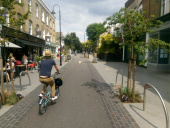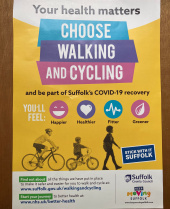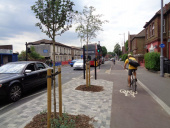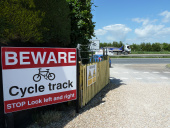West Sussex Transport Plan 2011-2026 (LTP3)
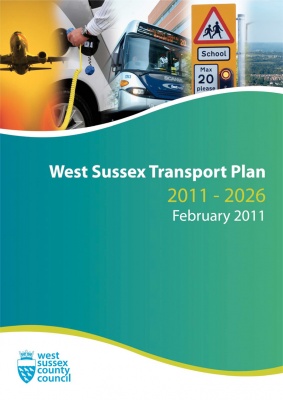
Document type:
Publisher:
Executive Summary
WSCC admits that cycling as a mode of transport has many advantages, but they won't build any cycling infrastructure unless "funding is available".
Objectives and Strategies
The plan lists the following four main objectives, and the strategies that WSCC says it will follow to achieve the objectives. Yellow highlights show items relevant to cycling as transport in West Sussex.
1. Promoting economic growth
- maintain or improve the reliability of journey times on key routes
- improve connectivity and access to local labour markets and key centres
- deliver transport improvements to support and facilitate sustainable growth
- ensure local transport networks are resistant and adaptable to shocks and impacts including climate change
2. Tackling climate change
- adapt transport infrastructure to increase its resilience to the effects of climate change
- support new low emission fuels, infrastructure and technologies
- reduce unnecessary trips by motorised vehicles and encourage the use of more sustainable modes of transport
- reduce the need to travel at all by encouraging provision of local services
- reduce the carbon footprint of the County Council’s own operations
- maximise reuse and recycling of materials in construction and maintenance
3. Providing access to services, employment & housing
- identify problem areas by using survey approaches and accessibility mapping techniques where appropriate
- work in partnership with service providers and stakeholders to set priorities
- ensure that accessibility is a central consideration when planning local services
- seek to ensure that places of work, education, leisure and food retail opportunities are located close together in new development
- enable disadvantaged people to access employment opportunities, key services, social networks and goods
- encourage local delivery of services so that people have to travel less
4. Improving safety, security & health
- reduce the risk of death or injury due to transport incidents through engineering, training and publicity particularly targeted at vulnerable road users
- reduce crime, fear of crime and antisocial behaviour on the transport network
- reduce the negative impacts of transport on public health
- to encourage and enable physically active travel such as walking and cycling through behaviour change initiatives and provision of information and education
- invest in new infrastructure which improves the County and creates safer conditions for all, and particularly vulnerable road users
Given that cycling as transport can, and does, solve many of the transport problems we face, it would seem likely that WSCC would be actively interested in investing in cycling. Sadly the opposite is true.
Priorities for WSCC
LTP3 is quite different to LTP2. While LTP2 also had four main objectives, they were all about transport. LTP3 introduces a new objective for the Transport Plan which is to "promote economic growth". This means that WSCC now puts most emphasis on increasing traffic flows on major roads, with the assumption that more traffic equals more economic growth. Rather than aiming to reduce motor traffic congestion, which may or may not hinder economic growth, WSCC now actively want to encourage more motor traffic on our biggest roads (and thus more congestion on all the others).
This aim to build motor traffic levels is emphasised explicitly:
Our Priorities for West Sussex
Our highest priorities will tackle the key issues we face and bring about radical improvements to quality of life for the people and businesses in the County. Our highest priorities are:
- Improvements to the A27 trunk road and complementary public transport improvements to the current bottlenecks at Chichester, Arundel and Worthing (not currently programmed) to increase capacity, improve reliability and safety and increase the competitiveness of local businesses and attract investment.
- Programmed improvements to the A23 trunk road at the current bottleneck between Handcross and Warninglid to increase capacity and improve the safety record.
- Maintaining the highway network.
- Whilst major schemes are a high priority for us, they are likely to take many years to deliver. It remains important that alongside these priorities we continue to work with our community to improve the safety record on our local roads, increase usage of healthy and sustainable modes of transport, and provide access to services.
Note how WSCC, rather cleverly, put improvements to the A27 and A23 as their top priorities. Both these roads are trunk roads, and the responsibility for investing in these roads rests with the Highways Agency, not WSCC. So the top two priorities don't actually involve WSCC spending any money at all!
Also note how they still say they want to "increase usage of healthy and sustainable modes of transport", which must surely include cycling. However this is an afterthought, and in practice it doesn't seem that they actually plan to invest in healthy or sustainable modes of transport at all.
Details of the Strategy
Given the top-level strategies, it would seem likely that West Sussex County Council will be planning to invest in the sustainable, active, non-polluting transport that is cycling. Later on in the document we see more detail for each strategy.
Reduce unnecessary trips by motorised vehicles and encourage use of more sustainable modes of transport
Many short distance trips which are particularly polluting are made by private car, especially in our urban areas where suitable alternatives are often available. We will encourage walking, cycling and using public transport where these are viable alternatives by:
and then there's a list of "soft measures" that all rely on "encouragement" and "travel plans".
It's also odd that they only mention pollution as the problem with short car trips. They ignore the biggest problem of all, urban motor congestion.
The next paragraph addresses the elephant in the room: you can't persuade people to cycle if the roads are too frightening to use!
At the same time, we recognise that existing services and facilities do not always meet the needs of communities and businesses. Therefore, where it is affordable, offers good value for money, and is prioritised by CLCs we will:
- invest in new walking facilities such as footways, crossings and signing
- invest in new cycling infrastructure particularly in our major towns but also on some multi-use, inter-urban and leisure routes where funding is available
Yet again we seen the undelying attitude: cycling and walking facilities are not always affordable. WSCC won't invest in such transport infrastructure unless the schemes jump through several planning hoops in the CLC process, and they won't invest their own money in cycling infrastructure at all.
Of course multi-million pound schemes to make motoring easier and more attractive don't have to be affordable, or offer good value for money, or even be prioritised by CLCs, according to WSCC's rules. Motoring appears to be "proper transport" and thus WSCC will invest its own money in new road schemes for cars. Road schemes for cars are also considered the only way to enhance the economy, and so they are made the top priorities for WSCC planning and investment.
Road transport investment, in West Sussex, only extends to private cars and lorries. The council don't like investing in buse services, even though a large proportion of the population don't have access to a car, or aren't able to drive. Consequently we're seeing year-on-year cuts to bus services, and people in towns and villages being left without any form of transport to use. WSCC can only think about getting more people into their cars, no other transport mode matters in their plans.
Reduce the negative impacts of transport on public health
The transport network can affect public health by contributing to poor air quality and noise issues and by affecting travel behaviour which can lead to inactivity and obesity. We will reduce the negative impacts of transport on public health by:
- ...
- encouraging healthy travel behaviour through school travel, healthy schools and other behaviour change initiatives such as School Travel Planning and Travelwise
- including new infrastructure in an Infrastructure Plan which encourages and promotes healthy behaviour such as walking and cycling
This sounds OK, although school travel plans and TraveWise have been running for decades now, with no effect at all on cycling modal share in the County. It's also odd that only travel to school is considered: what about all the other non-healthy trips that people routinely make by car?
Including new infrastructure in an Infrastructure Plan sounds good, though.
Page 20 says:
Encourage and enable physically active travel through behaviour change initiatives
Where transport infrastructure is in place, there are a range of behaviour change activities and initiatives which have been shown to increase its use. We will continue to do this by:
Before they've even started, they're putting the massive proviso in place that they'll only encourage physically active travel "where transport infrastructure is in place". Which makes a lot of sense, as travelling to most schools in the county by bicycle is not something you'd want to encourage people to do, under current road conditions. So this means they must be investing in new infrastructure, so that in future they will be able to encourage and enable physically active travel?
It seems not:
Invest in new infrastructure which creates safer conditions for all, and particularly vulnerable road users
Our investment programmes will be delivered if and when funding is available to deliver them.
Which basically means "We won't invest in infrastructure for vulnerable road users". If WSCC did want to invest, they have their own budget of tens of millions per annum they could allocate some money from. Instead they refuse to spend their own money, which is earmarked for schemes to make motoring more convenient and attractive, and require cycling infrastructure schemes to be funded by external sources, typically S106 impact-mitigation funding from developers.
WSCC Highways also pass the buck for planning cycle infrastructure to local County Local Committee groups:
Implementation priorities will be identified on a local basis by CLCs which will prioritise schemes in an Infrastructure Plan that also seeks to protect and/or enhance the built and natural environment of the County.
Not only are they passing all responsibility to the CLCs, who have a multitude of other issues to consider, they are apparently adding the additional requirement (on top of "funding being available") that new infrastructure for vulnerable road users should also have to protect and/or enhance the environment. One might wonder whether they expect their top-priority road-building schemes for the A23 and A27 to also protect and/or enhance the environment?
We also recognise the value that leisure facilities can have by encouraging healthy behaviour and by creating safer infrastructure where it is needed to encourage leisure journeys. Where it is affordable and schemes are prioritised by CLCs, we will support this by:
- investing in new or improved cycling infrastructure in our major towns and on some inter-urban and rural routes, where there is a clear case for doing so, to provide safer conditions for cyclists
- ...
- investing in a programme of safer routes to school and school safety zones to introduce advisory 20mph speed limits near schools at pick-up/drop-off times
- ...
Here we have WSCC explicitly saying that "cycling infrastructure in our major towns" and "safer routes to schools" are merely leisure facilities. Cycle infrastructure in towns does not count as transport infrastructure, in the eyes of WSCC planners!
Worse, these "leisure facilities" will only be invested in if they are "affordable" and when CLCs have prioritised the schemes above all the other things they have on their Community Issues Lists. So there is absolutely no commitment from WSCC to invest in any of these things, at all.
Cycling Infrastructure & Promotion in West Sussex
On page 31 the document addresses cycling infrastructure and promotion directly.
Cycling is one of the most sustainable transport modes and offers tremendous potential for improving our society’s health, economic efficiency and mobility, in addition to helping us tackle climate change. Maintaining or increasing the levels of cycling in West Sussex is, therefore, very important and will contribute to each of our objectives.
Here we have WSCC admitting that cycling is a mode of transport that can help contribute to each of their objectives. Yet they seem content with "maintaining" current levels of cycling in the county, rather than actively wishing to increase cycling levels to achieve useful modal share from motoring, with all its problems, to cycling, a solution to almost all the problems.
So what is their approach to cycling infrastructure and promotion?
The key aspects of our approach to cycling are:
- Cycle Network Construction – gaining a better understanding of, and overcoming, barriers which deter people from cycling. Using a wide range of physical infrastructure, construct and improve joined up town cycle networks and public rights of way which are linked in to new development. While balancing the needs of all users of the transport system, cycle network infrastructure could include; cycle lanes, cycle tracks, signing, cycle stands, shared surfaces, toucan crossings, reduced speed limits, traffic calming, and refuges to suit local circumstances.
- Maintaining Cycle Infrastructure – maintain infrastructure to a good standard using an asset management approach which considers whole life costs, making improvements where these are needed and are affordable.
- Travel Behaviour Change Initiatives – travel planning and promotional initiatives to encourage cycling and to identify local issues in schools, communities, businesses and new developments.
- Skills Training – Bikeability cycle skills training to equip our community, and particularly the most vulnerable, with the skills they need, reinforced by education delivered through school travel planning.
- Community Involvement – involving the cycling community to highlight local priorities and to develop cycling infrastructure and initiatives to meet local needs.
- Promoting Cycling – communicating the benefits of cycling through our Staff Travel Plan and by supporting national and local awareness events with our partners.
First, they say they will try to understand what barriers there are that deter people from cycling. They then list a whole load of different types of cycle infrastructure that could, but not would, be used. They don't say they'll actually construct any cycle networks, they merely aim to "overcome barriers". Note also the now-expected proviso: "balancing the needs of all users of the transport system" which means "so long as this doesn't have any negative impact on motoring".
Then they say they'll maintain what little cycle infrastructure there is, but, again, only "when needed" and "when affordable". It's not clear who decides whether cycle infrastructure maintenance is needed or affordable, but clearly mainenance is optional - they won't maintain all cycle infrastructure as a matter of course.
The final four points are the classic, well-known, "soft" measures. Rather than investing real money in cycle infrastructure that would be safe and attractive for anyone to use, WSCC prefer to spend their apparently-limited funds on training people to ride their bikes in the currently-terrible road conditions that are the main reason people don't use bicycles more for local transport. They ignore that fact that cycling levels in West Sussex have remained constant over the last decades of TravelWise and BikeAbility and Workplace Cycle Challenges and other encouragement: these methods just don't have any significant effect. They also ignore the huge growth in cycling levels where safe cycleways have been provided: such as the Downs Link, Centurion Way, and the coastal NCN2 between Shoreham and Worthing.
As for involving the cycling community (what's that?) to highlight local priorities - the Worthing Cycle Forum has a long list of infrastructure requirements to meet local needs, now sitting on the Worthing CLC's Community Issues List, where they seem destined to remain, unimplemented, for many years.
Community Involvement and Programme Development
This section of the document claims that WSCC has involved the community in developing it's transport plan.
A 12 week consultation on the Provisional West Sussex Transport Plan 2011-2026 was held from July to September 2010. A large number of comments were received during the consultation and the key response themes included:
- the need to focus on improvements to the strategic road network, particularly the A27 at and around Worthing, Arundel and Chichester
- contrasting comments about the need to focus on cycling and walking improvements to get people out of their cars and help the local environment and transport emissions
- ...
It would appear that WSCC listened hard to the feedback about the A27, but have ignored the contrasting comments that would be a much cheaper and more sustainable solution to transport problems in the county. Building new roads, and improving existing ones, is proven to generate more traffic than if the road system is left alone.
Under the heading "Partnership Working", the council lists all the groups it has apparently worked with. Included in this list is:
West Sussex Cycle Forum
A forum comprising a number of cycling interest groups, sustainable access groups and individuals with the aim of promoting cycling as a form of transport and pressing for improved road safety for nonmotorised users.
Which is nice, although the Forum members do not remember actually being consulted on the cycling aspects of the Transport Plan at all. Had we been consulted we would have pushed hard to have the plan include a real commitment to cycling, especially investing in cycle infrastructure, and not "when funding is available".
For the various reasons given above, the West Sussex Cycling Forum most certainly does not support the West Sussex Local Transport Plan 2011-2026.
- Log in to post comments

